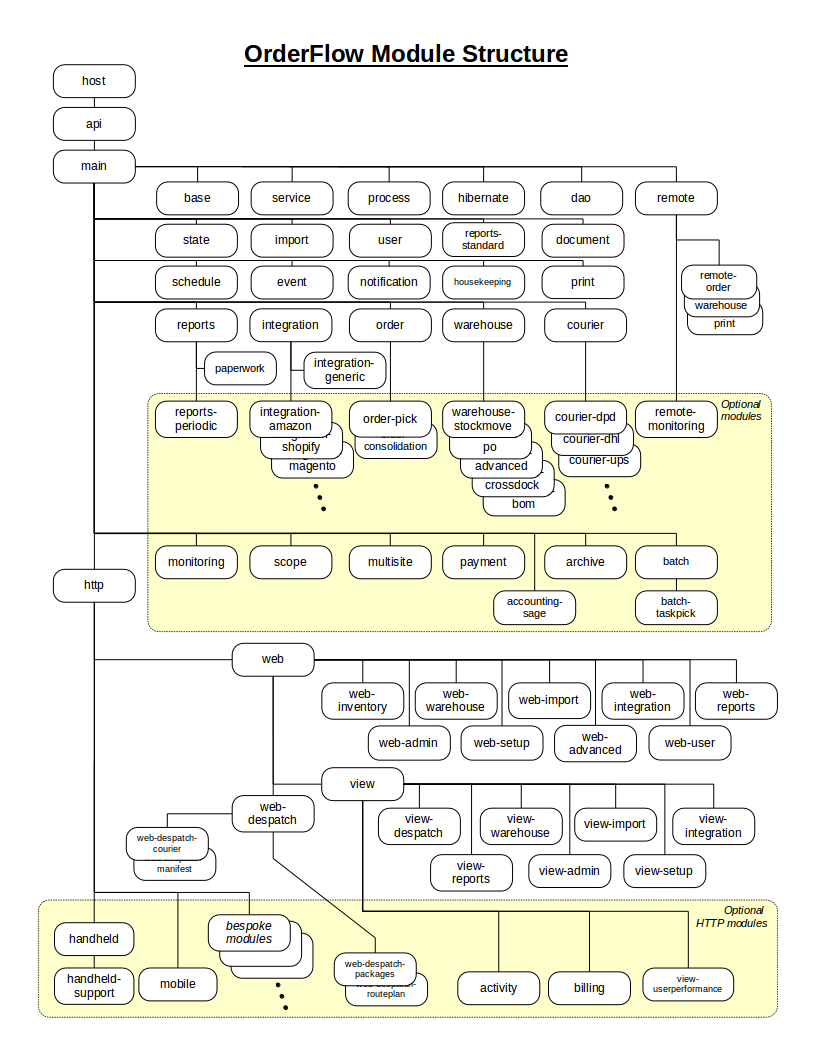Development View
Development View
This section provides a development view of OrderFlow's architecture.
OrderFlow is a modular application, whose modularity is delivered using the
Impala dynamic modular productivity framework (now hosted on GitHub).
This allows the separation of source code into manageable parts that share a
similar function.
The modular approach to the way the system is constructed also serves an important commercial purpose in that it allows bespoke functionality to be built in a way that does not affect the rest of the code base. This allows OrderFlow to be adapted to quite bespoke customer needs without introducing any unnecessary complexity or inconsistencies in the way the rest of the system works.
Modules are loaded when the application is started, and only functionality that is present in loaded modules is available to execute.
OrderFlow has the concept of core and optional modules. Core modules are included within the base distribution of OrderFlow, so are available automatically to all OrderFlow customers. Optional modules contain more advanced features that are made available by commercial agreement according to the needs of the OrderFlow customers.
Module Structure
OrderFlow's modules are organised in a hierarchical structure, with child modules inheriting functionality from their parents.
The following diagram shows the module structure of OrderFlow; an explanation follows the diagram.

Top-level Modules
Host Module
The top-most module in OrderFlow is the host module. This is what the web server container runs, since it contains the application's deployment descriptor (i.e. its web.xml configuration file). The host module also contains other configuration such as the Spring application context, plus other system, data access and logging properties. (These properties can be overridden in a deployed system by entries in files on the filesystem.)
The host module also contains the following:
- The application's landing page, i.e. index.htm.
- Source code for environment and performance logging, servlet filters, session termination and data source loading.
- The OrderFlow printing applet Java Archive (JAR) file.
- All JavaScript, Cascading Style Sheets (CSS), built-in images/icons and the application's URL icon.
- Version information for the application.
API Module
The api module of OrderFlow contains no Spring bean implementations, but instead defines most of the interfaces, entity classes and other non-entity classes used for encapsulating multiple data objects into a single object.
All other modules (apart from host) have visibility of the interfaces in the api module. Implementations of these interfaces may be present in any of the underlying modules.
Main Module
The main module contains more interface declarations, plus utility classes that are useful for many of OrderFlow's modules. It also contains a handful of api interface implementations, including universally-useful implementations of templating and report configuration interfaces.
The main module imports a significant number of Spring bean implementations (e.g. DAO implementations) into its Spring context file, in order to make them visible to all sub-modules. This prevents all sub-modules from having to repeat the same import statements.
Core Modules
The core modules in OrderFlow comprise of modules that are essential to the running of the application. They provide the basic, minimum functionality that the system offers.
Modules such as order, warehouse, courier, reports, notification and service contain core functionality, without which orders would not be progressible through the system.
Additionally, the DAO implementations in the logical data access layer are contained in the dao core module.
Optional Modules
Optional (or 'non-core') modules in OrderFlow contain functionality that is not essential for the running of the system, but enhances it in some way.
For example, different couriers and integration solutions are supported in their own modules.
Also, OrderFlow's multi-site, multi-channel/organisational capabilities are present in the
multisite and scope modules respectively.
If these optional modules are not loaded in a particular instance of OrderFlow, the functionality will not be available. This optional nature allows the deployed application size to be reduced where necessary, and it also provides a greater degree of control over where optional functionality is deployed. This can help OrderFlow to enforce commercial arrangements, such as giving exclusivity over certain functionality.
HTTP Modules
The http module and its sub-modules are all concerned with supporting OrderFlow's user interfaces. The core http modules support the desktop interface - those prefixed with 'web' are loosely divided into modules according to the top-level tabs in the desktop interface.
Modules prefixed with 'view' are concerned with providing the dashboard functionality throughout the desktop interface. This functionality allows what appears on OrderFlow's user interface to be tailored according to a specific customer's needs, without needing to rebuild or even restart the application.
Optional HTTP Modules
Similarly to the optional core modules, the optional http modules contain user interface functionality that is not essential for the running of OrderFlow, but add additional features.
These additional features include the handheld interface, which is a user interface dedicated to run on ruggedised handheld warehouse computers. Not all customers use handheld devices in the warehouse, so this module is considered optional.
Finally, modules that contain bespoke functionality for specific customers are optional, for obvious reasons. These modules can contain functionality that may or may not be geared towards the user interface, i.e. they may also contain tailored internal logic if a particular customer requires this. Separating bespoke functionality into dedicated customer modules defines clear boundaries and provides a layer of insulation from the core system functionality.
